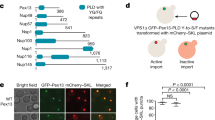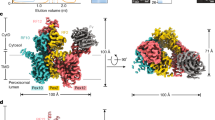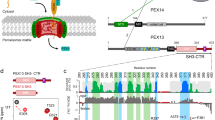Abstract
Peroxisomes import folded, even oligomeric, proteins, which distinguishes the peroxisomal translocation machinery from the well-characterized translocons of other organelles. How proteins are transported across the peroxisomal membrane is unclear. Here, we propose a mechanistic model that conceptually divides the import process into three consecutive steps: the formation of a translocation pore by the import receptor, the ubiquitylation of the import receptors, and pore disassembly/receptor recycling.
This is a preview of subscription content, access via your institution
Access options
Subscribe to this journal
Receive 12 print issues and online access
$189.00 per year
only $15.75 per issue
Buy this article
- Purchase on Springer Link
- Instant access to full article PDF
Prices may be subject to local taxes which are calculated during checkout


Similar content being viewed by others
References
Brown, L. A. & Baker, A. Peroxisome biogenesis and the role of protein import. J. Cell. Mol. Med. 7, 388–400 (2003).
Eckert, J. H. & Erdmann, R. Peroxisome biogenesis. Rev. Physiol. Biochem. Pharmacol. 147, 75–121 (2003).
Vizeacoumar, F. J., Torres-Guzman, J. C., Bouard, D., Aitchison, J. D. & Rachubinski, R. A. Pex30p, Pex31p, and Pex32p form a family of peroxisomal integral membrane proteins regulating peroxisome size and number in Saccharomyces cerevisiae. Mol. Biol. Cell 15, 665–677 (2004).
Vizeacoumar, F. J., Torres-Guzman, J. C., Tam, Y. Y., Aitchison, J. D. & Rachubinski, R. A. YHR150w and YDR479c encode peroxisomal integral membrane proteins involved in the regulation of peroxisome number, size, and distribution in Saccharomyces cerevisiae. J. Cell Biol. 161, 321–332 (2003).
Schnell, D. J. & Hebert, D. N. Protein translocons: multifunctional mediators of protein translocation across membranes. Cell 112, 491–505 (2003).
Gouveia, A. M., Reguenga, C., Oliveira, M. E., Sa-Miranda, C. & Azevedo, J. E. Characterization of peroxisomal Pex5p from rat liver. Pex5p in the Pex5p–Pex14p membrane complex is a transmembrane protein. J. Biol. Chem. 275, 32444–32451 (2000).
Kikuchi, M. et al. Proteomic analysis of rat liver peroxisome: presence of peroxisome-specific isozyme of Lon protease. J. Biol. Chem. 279, 421–428 (2004).
Gouveia, A. M. et al. Characterization of the peroxisomal cycling receptor Pex5p import pathway. Adv. Exp. Med. Biol. 544, 219–220 (2003).
Huhse, B. et al. Pex17p of Saccharomyces cerevisiae is a novel peroxin and component of the peroxisomal protein translocation machinery. J. Cell Biol. 140, 49–60 (1998).
Agne, B. et al. Pex8p: an intraperoxisomal organizer of the peroxisomal import machinery. Mol. Cell 11, 635–646 (2003).
Chang, C. C., Warren, D. S., Sacksteder, K. A. & Gould, S. J. PEX12 interacts with PEX5 and PEX10 and acts downstream of receptor docking in peroxisomal matrix protein import. J. Cell Biol. 147, 761–774 (1999).
Schliebs, W. et al. Recombinant human peroxisomal targeting signal receptor PEX5. Structural basis for interaction of PEX5 with PEX14. J. Biol. Chem. 274, 5666–5673 (1999).
Gatto, G. J., Geisbrecht, B. V., Gould, S. J. & Berg, J. M. Peroxisomal targeting signal-1 recognition by the TPR domains of human PEX5. Nature Struct. Biol. 7, 1091–1095 (2000).
Eckert, J. H. & Johnsson, N. Pex10p links the ubiquitin conjugating enzyme Pex4p to the protein import machinery of the peroxisome. J. Cell Sci. 116, 3623–3634 (2003).
Reguenga, C., Oliveira, M. E., Gouveia, A. M., Sa-Miranda, C. & Azevedo, J. E. Characterization of the mammalian peroxisomal import machinery: Pex2p, Pex5p, Pex12p, and Pex14p are subunits of the same protein assembly. J. Biol. Chem. 276, 29935–29942 (2001).
Dalla Serra, M. & Menestrina, G. Liposomes in the study of pore-forming toxins. Methods Enzymol. 372, 99–124 (2003).
Gouaux, E. Channel-forming toxins: tales of transformation. Curr. Opin. Struct. Biol. 7, 566–573 (1997).
Oliveira, M. E., Gouveia, A. M., Pinto, R. A., Sa-Miranda, C. & Azevedo, J. E. The energetics of Pex5p-mediated peroxisomal protein import. J. Biol. Chem. 278, 39483–39488 (2003).
Salomons, F. A., Kiel, J. A., Faber, K. N., Veenhuis, M. & van der Klei, I. J. Overproduction of Pex5p stimulates import of alcohol oxidase and dihydroxyacetone synthase in a Hansenula polymorpha Pex14 null mutant. J. Biol. Chem. 275, 12603–12611 (2000).
Nair, D. M., Purdue, P. E. & Lazarow, P. B. Pex7p translocates in and out of peroxisomes in Saccharomyces cerevisiae. J. Cell Biol. 167, 599–604 (2004).
Purdue, P. E., Yang, X. & Lazarow, P. B. Pex18p and Pex21p, a novel pair of related peroxins essential for peroxisomal targeting by the PTS2 pathway. J. Cell Biol. 143, 1859–1869 (1998).
Schäfer, A., Kerssen, D., Veenhuis, M., Kunau, W. H. & Schliebs, W. Functional similarity between the peroxisomal PTS2 receptor binding protein Pex18p and the N-terminal half of the PTS1 receptor Pex5p. Mol. Cell. Biol. 24, 8895–8906 (2004).
van Roermund, C. W., Elgersma, Y., Singh, N., Wanders, R. J. & Tabak, H. F. The membrane of peroxisomes in Saccharomyces cerevisiae is impermeable to NAD(H) and acetyl-CoA under in vivo conditions. EMBO J. 14, 3480–3486 (1995).
van Roermund, C. W. et al. The peroxisomal lumen in Saccharomyces cerevisiae is alkaline. J. Cell Sci. 117, 4231–4237 (2004).
Lasorsa, F. M. et al. The yeast peroxisomal adenine nucleotide transporter: characterization of two transport modes and involvement in ΔpH formation across peroxisomal membranes. Biochem. J. 381, 581–585 (2004).
Erdmann, R. et al. PAS1, a yeast gene required for peroxisome biogenesis, encodes a member of a novel family of putative ATPases. Cell 64, 499–510 (1991).
Lupas, A. N. & Martin, J. AAA proteins. Curr. Opin. Struct. Biol. 12, 746–753 (2002).
Sauer, R. T. et al. Sculpting the proteome with AAA+ proteases and disassembly machines. Cell 119, 9–18 (2004).
Ogura, T. & Wilkinson, A. J. AAA+ superfamily ATPases: common structure — diverse function. Genes Cells 6, 575–597 (2001).
Arnold, I. & Langer, T. Membrane protein degradation by AAA proteases in mitochondria. Biochim. Biophys. Acta 1592, 89–96 (2002).
Kihara, A., Akiyama, Y. & Ito, K. Dislocation of membrane proteins in FtsH-mediated proteolysis. EMBO J. 18, 2970–2981 (1999).
Jarosch, E., Lenk, U. & Sommer, T. Endoplasmic reticulum-associated protein degradation. Int. Rev. Cytol. 223, 39–81 (2003).
Ye, Y., Meyer, H. H. & Rapoport, T. A. Function of the p97–Ufd1–Npl4 complex in retrotranslocation from the ER to the cytosol: dual recognition of nonubiquitinated polypeptide segments and polyubiquitin chains. J. Cell Biol. 162, 71–84 (2003).
Collins, C. S., Kalish, J. E., Morrell, J. C., McCaffery, J. M. & Gould, S. J. The peroxisome biogenesis factors Pex4p, Pex22p, Pex1p, and Pex6p act in the terminal steps of peroxisomal matrix protein import. Mol. Cell. Biol. 20, 7516–7526 (2000).
Birschmann, I. et al. Pex15p of Saccharomyces cerevisiae provides a molecular basis for recruitment of the AAA peroxin Pex6p to peroxisomal membranes. Mol. Biol. Cell 14, 2226–2236 (2003).
Matsumoto, N., Tamura, S. & Fujiki, Y. The pathogenic peroxin Pex26p recruits the Pex1p–Pex6p AAA ATPase complexes to peroxisomes. Nature Cell Biol. 5, 454–460 (2003).
Purdue, P. E. & Lazarow, P. B. Pex18p is constitutively degraded during peroxisome biogenesis. J. Biol. Chem. 276, 47684–47689 (2001).
Platta, H. W., Girzalsky, W. & Erdmann, R. Ubiquitination of the peroxisomal import receptor Pex5p. Biochem. J. 384, 37–45 (2004).
Kiel, J. A., Emmrich, K., Meyer, H. E. & Kunau, W. H. Ubiquitination of the peroxisomal targeting signal type 1 receptor, Pex5p, suggests the presence of a quality control mechanism during peroxisomal matrix protein import. J. Biol. Chem. 280, 1921–1930 (2005).
Kragt, A., Voorn-Brouwer, T. M., Van den Berg, M. & Distel, B. The Saccharomyces cerevisiae peroxisomal import receptor Pex5p is monoubiquitinated in wild type cells. J. Biol. Chem. 280, 7867–7874 (2005).
Koller, A. et al. Pex22p of Pichia pastoris, essential for peroxisomal matrix protein import, anchors the ubiquitin-conjugating enzyme, Pex4p, on the peroxisomal membrane. J. Cell Biol. 146, 99–112 (1999).
Crane, D. I., Kalish, J. E. & Gould, S. J. The Pichia pastoris PAS4 gene encodes a ubiquitin-conjugating enzyme required for peroxisome assembly. J. Biol. Chem. 269, 21835–21844 (1994).
van der Klei, I. J. et al. The ubiquitin-conjugating enzyme Pex4p of Hansenula polymorpha is required for efficient functioning of the PTS1 import machinery. EMBO J. 17, 3608–3618 (1998).
Wiebel, F. F. & Kunau, W. -H. The PAS2 protein essential for peroxisome biogenesis is related to ubiquitin-conjugating enzymes. Nature 359, 73–76 (1992).
Joazeiro, C. A. & Weissman, A. M. RING finger proteins: mediators of ubiquitin ligase activity. Cell 102, 549–552 (2000).
Xie, Y. & Varshavsky, A. The E2–E3 interaction in the N-end rule pathway: the RING-H2 finger of E3 is required for the synthesis of multiubiquitin chain. EMBO J. 18, 6832–6844 (1999).
Bellu, A. R., Komori, M., van Der Klei, I. J., Kiel, J. A. & Veenhuis, M. Peroxisome biogenesis and selective degradation converge at Pex14p. J. Biol. Chem. 276, 44570–44574 (2001).
Titorenko, V. I. & Rachubinski, R. A. Peroxisomal membrane fusion requires two AAA family ATPases, Pex1p and Pex6p. J. Cell Biol. 150, 881–886 (2000).
Tolbert, N. E. & Essner, E. Microbodies: peroxisomes and glyoxysomes. J. Cell Biol. 91, 271–283 (1981).
van den Bosch, H., Schutgens, R. B., Wanders, R. J. & Tager, J. M. Biochemistry of peroxisomes. Annu. Rev. Biochem. 61, 157–197 (1992).
Wanders, R. J. Metabolic and molecular basis of peroxisomal disorders: a review. Am. J. Med. Genet. A 126, 355–375 (2004).
Michels, P. A., Hannaert, V. & Bringaud, F. Metabolic aspects of glycosomes in trypanosomatidae — new data and views. Parasitol. Today 16, 482–489 (2000).
Opperdoes, F. R. & Borst, P. Localization of nine glycolytic enzymes in a microbody-like organelle in Trypanosoma brucei: the glycosome. FEBS Lett. 80, 360–364 (1977).
Veenhuis, M., van der Klei, I. J., Titorenko, V. & Harder, W. Hansenula polymorpha: an attractive model organism for molecular studies of peroxisome biogenesis and function. FEMS Microbiol. Lett. 79, 393–403 (1992).
Marzioch, M., Erdmann, R., Veenhuis, M. & Kunau, W. -H. PAS7 encodes a novel yeast member of the WD-40 protein family essential for import of 3-oxoacyl-CoA thiolase, a PTS2-containing protein, into peroxisomes. EMBO J. 13, 4908–4918 (1994).
Dodt, G. & Gould, S. J. Multiple PEX genes are required for proper subcellular distribution and stability of Pex5p, the PTS1 receptor: evidence that PTS1 protein import is mediated by a cycling receptor. J. Cell Biol. 135, 1763–1774 (1996).
Dammai, V. & Subramani, S. The human peroxisomal targeting signal receptor, Pex5p, is translocated into the peroxisomal matrix and recycled to the cytosol. Cell 105, 187–196 (2001).
Kunau, W. Peroxisomes: the extended shuttle to the peroxisome matrix. Curr. Biol. 11, 659–662 (2001).
Gould, S. J. & Collins, C. S. Peroxisomal-protein import: is it really that complex? Nature Rev. Mol. Cell Biol. 3, 382–389 (2002).
Azevedo, J. E., Costa-Rodrigues, J., Guimaraes, C. P., Oliveira, M. E. & Sa-Miranda, C. Protein translocation across the peroxisomal membrane. Cell Biochem. Biophys. 41, 451–468 (2004).
Acknowledgements
We thank W.-H. Kunau and H. Rottensteiner for critically reading this manuscript. We gratefully acknowledge M. Veenhuis for kindly sharing electron micrographs. Work in our laboratories is supported by grants from the Deutsche Forschungsgemeinschaft, the European Union and the Fonds der Chemischen Industrie. We apologize to the many researchers whose work we could not cite due to space limitations.
Author information
Authors and Affiliations
Corresponding author
Ethics declarations
Competing interests
The authors declare no competing financial interests.
Rights and permissions
About this article
Cite this article
Erdmann, R., Schliebs, W. Peroxisomal matrix protein import: the transient pore model. Nat Rev Mol Cell Biol 6, 738–742 (2005). https://doi.org/10.1038/nrm1710
Published:
Issue Date:
DOI: https://doi.org/10.1038/nrm1710
This article is cited by
-
Modulation of peroxisomal import by the PEX13 SH3 domain and a proximal FxxxF binding motif
Nature Communications (2024)
-
The peroxisome: an update on mysteries 3.0
Histochemistry and Cell Biology (2024)
-
Peroxisome biogenesis initiated by protein phase separation
Nature (2023)
-
A defect in the peroxisomal biogenesis in germ cells induces a spermatogenic arrest at the round spermatid stage in mice
Scientific Reports (2019)
-
Current Advances in Protein Import into Peroxisomes
The Protein Journal (2019)



